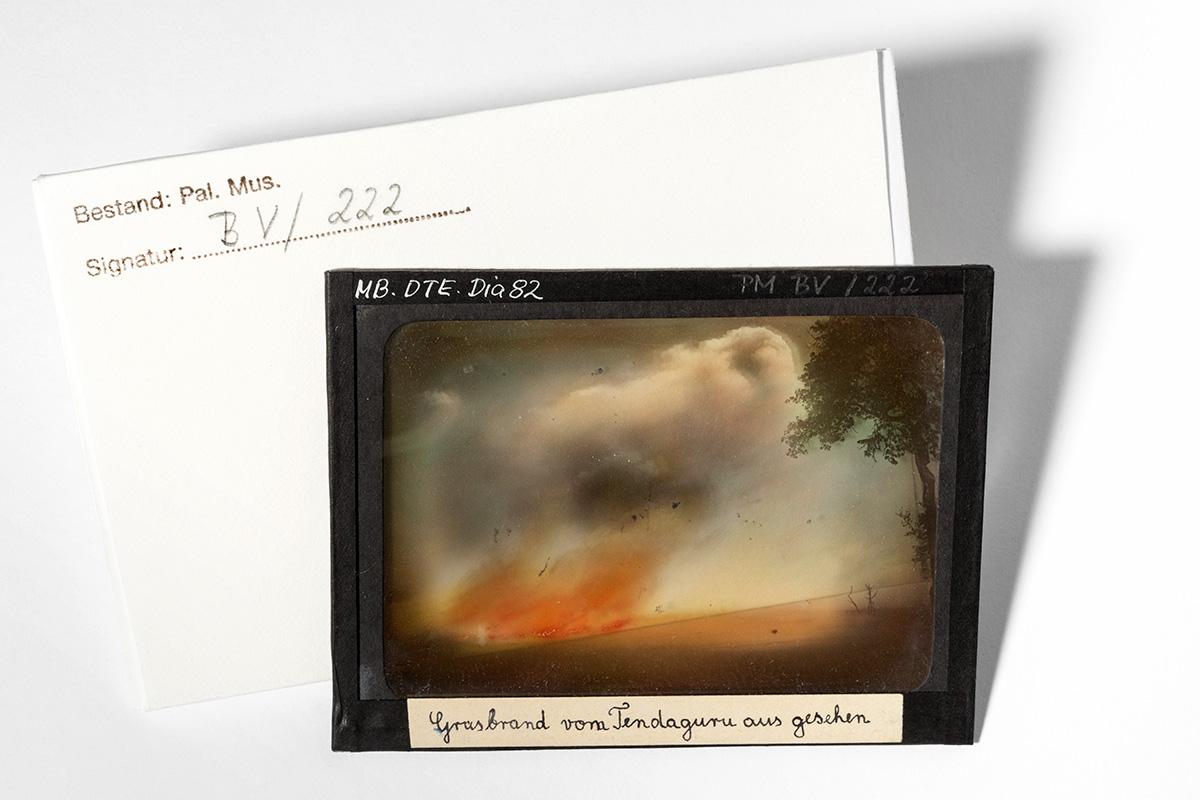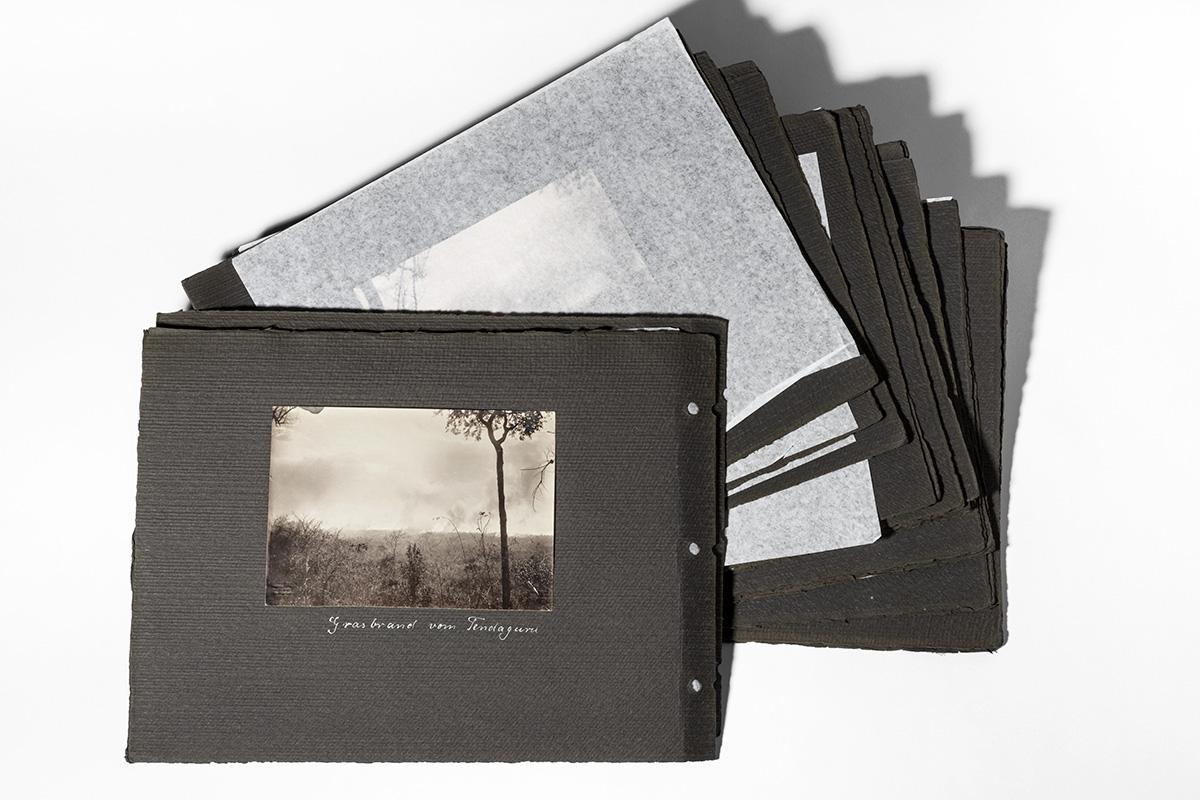Paula Zwolenski, Oktober 2020
At first sight, this landscape photograph seems to be out of place in the archive: The glass slide is part of a collection of one of the most important excavations of dinosaur bones in history. The motif, however, shows a bush fire with clouds of ash spreading in a north-eastern direction. The data noted on the slide frame ("MB.DTE.Dia82") as well as the handwritten title "Grasbrand vom Tendaguru aus gesehen” (Grass Fire seen from Tendaguru) refer to the Deutsche Tendaguru Expedition (1909–1913), abbreviated "DTE", which made the sensational discovery of the famous Brachiosaurus Brancai bones. It was carried out in the former colony of German East Africa (1885–1918), today Tanzania. What was the slide used for, what role did this seemingly marginal natural event play during the expedition, and what is the significance of the glass slide today?
The expedition leaders Edwin Hennig (1882–1977) and Werner Janensch (1878–1969) documented the excavation work with a plate camera. After the glass negatives were exposed on site, they were sent to Germany to be developed and evaluated. There they were then printed on paper, pasted into albums, and published in magazines. Slides were also produced. The present object is one of the few colourised glass slides in the photographic collection. According to the Sitzungsberichte der Gesellschaft Naturforschender Freunde zu Berlin of 1909 and 1912, the slides were used in lectures after the expedition, where they would have been shown using special projectors. The protective frame, which bears several traces of fingerprints, allowed for the slides to be used frequently without destroying the images. To make them available to users, the archivists of the Historical Division enclosed the slides in archival sleeves and labelled them accordingly. The signature "PM B V/222" refers to the object number "222", which is part collection number "V" (slides) within the image collection ("B" for “Bild”) of the Palaeontological Museum ("PM").
As in the case of the Valdivia expedition, the Tendaguru photographs not only depict collected objects and excavation sites, but also landscapes, workers, and everyday life. They documented working routines on the one hand, and, on the other hand, they demonstrated the progress of the expedition: their publication in newspapers, for example, secured public interest and the attention of sponsors. While photographs were considered to be particularly 'authentic', they have always been open to technical manipulation. It should also be remembered that the Tendaguru photographs were strongly influenced by the colonial aspirations of the Prussian Empire around 1900. Thus, they convey political views that need to be critically examined.
So far, the circumstances of the fire and its effects on the expedition remain a matter of speculation. It can be assumed that the image was part of the reporting on the expedition at some point. The traces of use left behind on the slides give us glimpses into the scientific work surrounding the expedition: on site, in the immediate post-processing, and in today's archive. They also help us to reflect on the production and use of images in the early twentieth century against the backdrop of German colonial politics.
Object Profile
- Name: glass slide "Grasbrand vom Tendaguru aus gesehen" (Grass Fire seen from Tendaguru)
- Signatures: MB.DTE.Dia82 (old signature), PM B V/222 (Historical Division)
- Provenance: Tendaguru-expedition (Tanzania, 1909–1913), Paleontological Museum at the Museum für Naturkunde Berlin, Historical Division at the Museum für Naturkunde Berlin
- Material: glass slide (coloured) with notes on frame
- Photogrophers: Werner Janensch (1878–1869) or Edwin Hennig (1882–1977)
- Date of production: between 1909 and 1913
- Place of production: Tendaguru, Tanzania
- Keywords: Tendaguru-expedition, landscape, German East Africa, glass slide, Tendaguru, Tanzania, Werner Janensch, Edwin Hennig
Bibliography
- Ina Heumann et al. (eds.): Dinosaurierfragmente – Zur Geschichte der Tendaguru-Expedition und ihrer Objekte,1906–2017, Göttingen 2018.
- Kunstgeschichtliches Seminar der Universität Hamburg: "Dia-Herstellung", in: Diaarchiv des kunstgeschichtlichen Seminars der Universität Hamburg (last accessed: 15.10.2020).
- Maria Männing: "Bruno Meyer and the Invention of Art Historical Slide Projection", in: Photo-Objects: On the Materiality of Photographs and Photo Archives in the Humanities and Sciences, ed. by Julia Bärnighausen et al., Edition Open Access, Studies 12, Max Planck Institut für Wissenschaftsgeschichte Berlin, pp. 275–290, Link to the Open Access article, last accessed: 17.10.2020).
- Marco Tamborini and Mareike Vennen: "Disruptions and Changing Habits: The case of the Tendaguru expedition", in: Museum History Journal, vol. 10 (2017), no. 2, pp. 183–199. DOI 10.1080/19369816.2017.1328872 (last accessed: 17.10.2020).
- Mareike Vennen: "Träger-Arbeiten. Die Zirkulation kolonialer Dinge und Bilder der Tendaguru-Expedition (1909–1913)", in: Der Träger. Zu einer 'tragenden' Figur der Kolonialgeschichte, ed. by Sonja Malzner and Anne D. Peiter, Bielefeld 2018, pp.157–180.
Sources
- Edwin Hennig: "Die Entstehung der Dinosaurier-Lager", in: Sitzungsberichte der Gesellschaft Naturforschender Freunde, vol. 1912, no. 2b, pp. 137–142.
- Werner Janensch: "Erster Bericht über die Tendaguru-Expedition", in: Sitzungsberichte der Gesellschaft Naturforschender Freunde zu Berlin, vol. 1909, no. 1, pp. 358–360.
- Gustav Tornier: "Vorbericht über die Festsitzung für die Tendaguru-Expedition", in: Sitzungsberichte der Gesellschaft Naturforschender Freunde zu Berlin, vol. 1912, no. 2b, pp. 115–120.
Image Credits
- Fig. 1: "Grasbrand vom Tendaguru aus gesehen" (Grass fire seen from Tendaguru), glass slide (coloured, frame with notes), N. N., 1909–1913, 9 x 12 cm, MfN, HBSB, PM BV/222, © Carola Radke, MfN.
- Fig. 2: "Grasbrand vom Tendaguru" (Grass Fire seen from Tendaguru), silver gelatine print mounted in album, N.N., 1909–1913, 25,5 x 35 x 4 cm, MfN, HBSB, PM BIV/262, © Carola Radke, MfN.

